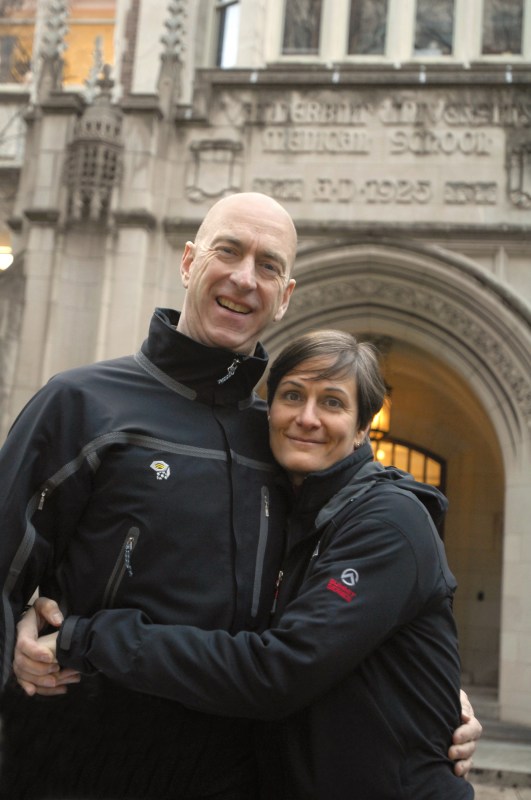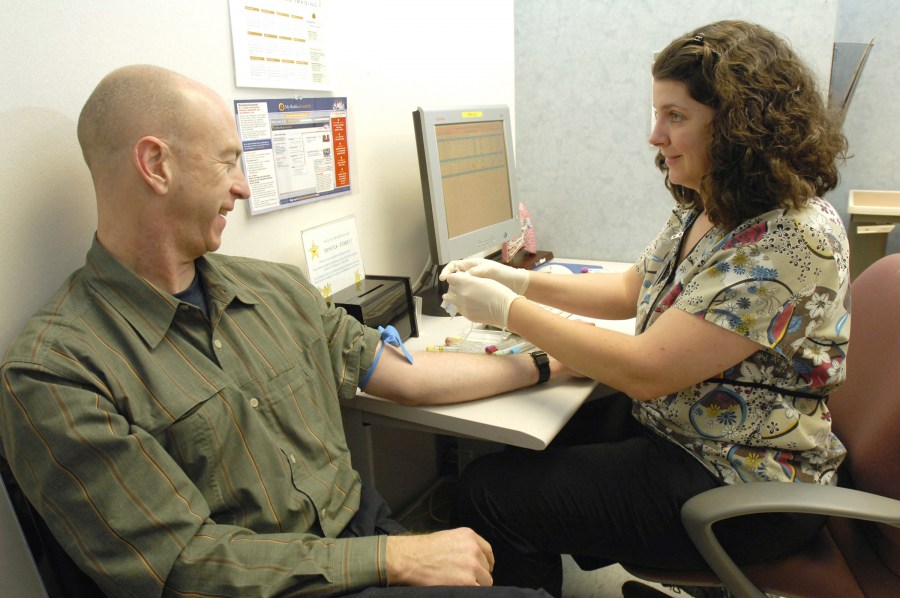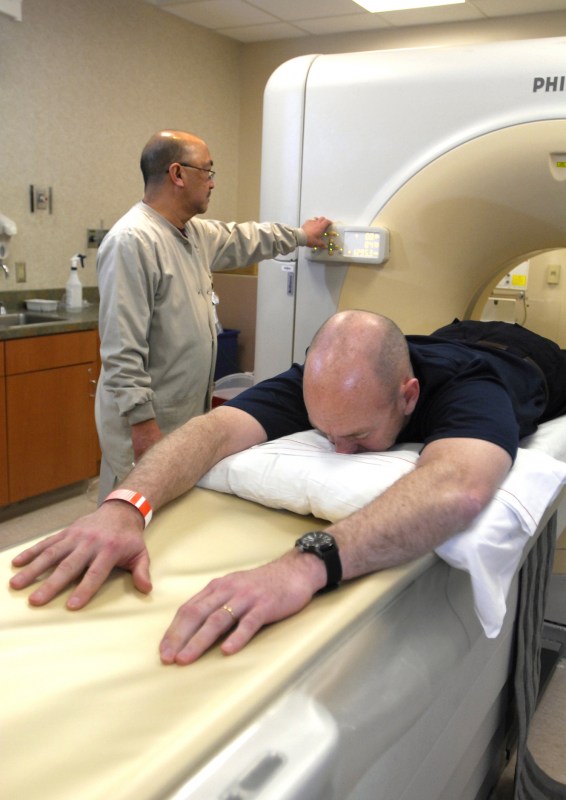
Ed Dailey, here with his wife, Carol, is taking part in a Vanderbilt study of familial idiopathic pulmonary fibrosis. (photo by Anne Rayner)
Study traces family ties of pulmonary fibrosis
Ed Dailey flew from Wayne, Pa., to Nashville on a snowy February day to undergo blood work, a CT scan and bronchoscopy at Vanderbilt.
But Dailey is not sick. In fact, there is nothing wrong with him. He agreed to undergo the invasive procedures because he wants to help researchers understand the disease that affects four members of his family.
Dailey's is one of more than 260 families enrolled in a study of familial idiopathic pulmonary fibrosis (IPF), which recently received an $11 million program project grant from the National Heart, Lung and Blood Institute. It is among the largest collections of people with this disease in the world, said Timothy Blackwell, M.D., professor of Medicine and lead investigator.

Study participant Ed Dailey has blood drawn by Wendi Mason, A.C.N.P., in the pulmonary clinic. (photo by Anne Rayner)
The grant will fund three research projects to study the genetics and underlying biological mechanisms that lead to progressive fibrosis in the lungs.
Blackwell leads the first project. He is studying unaffected family members of people who have familial IPF or died from it. Dailey's grandfather and uncle died from the disease, and his mother and sister are living with it. Dailey is 47 and shows no sign of the disease.
“I chose to become involved in the study not necessarily for myself, but for future generations in both my family and other families who are affected by familial IPF,” Dailey said. “With a little luck, my small contribution will help others in the future.”
Blackwell's project studies what happens in the earliest point of the disease. With advanced disease, a large portion of the lung has been replaced by fibrotic tissue. Patients with IPF already have scarring by the time they come to biopsy, lung transplant or autopsy.
“In this disease, it is hard to know what is a cause and what is a result,” Blackwell said. “Many of the pathways and cells thought to play a role in the disease may be just a response to injury or repair rather than an initiating cause.”
“Our hypothesis is that in IPF epithelial cells lining the air sacs are critically important in driving an ongoing injury repair process that leads to fibrosis. To understand how this works we need to investigate the mild changes that occur in the lungs of some at-risk family members — most of whom will never develop clinical disease.”

Ed Quirante, R.T., left, monitors Ed Dailey during his CT scan. (photo by Anne Rayner)
It is estimated that 10 percent to 20 percent of IPF cases may be familial. There are four genes in two gene families that have been linked to IPF, but those account for only 12 percent to 15 percent of familial cases. The big genetic contributors have not been discovered yet.
“That's really the reason for putting this program together — understanding the genetics, combining this with data regarding the earliest disease manifestations in the lungs, and then applying this information to the more common sporadic form of the disease,” Blackwell said.
The second project funded by the program project grant is led John Phillips III, M.D., who will look at the genetics of the disease and whether there are other mutations that haven't been identified in these families who account for a large portion of the disease.
Many people with familial IPF have short telomeres, which are the sequences at the end of chromosomes. These may be the most common group of mutations, but the study will look at those families with other genetic mutations as well.
“Our goals — to locate where IPF falls on the human gene map, discover how and why genetic variations cause IPF and identify potential treatments for IPF — are within sight,” said Phillips, director of the Division of Medical Genetics and Genomic Medicine in Pediatrics. “Our IPF team's combined use of pulmonary and genetic strategies promises to provide a pulmonary arm to the Human Genome Project.”
David Schwartz, M.D., professor of Medicine at National Jewish Health in Denver, is leading the third project, which will search for abnormalities in other genes and how they collaborate with environmental exposure, such as smoking, to cause disease. Also of interest are the herpes viruses, which may be important in causing clinical disease in someone who has the right genetic predisposition.
“Receiving this grant is a major advance in our capability to investigate the pathogenetic mechanisms that underlie idiopathic pulmonary fibrosis.The work conducted herein will provide the understanding that is necessary to develop effective treatments in the future,” said James Loyd, M.D., the Rudy W. Jacobson Professor of Pulmonary Medicine and a core leader for the program project grant.
“The success of the award is due to Dr. Blackwell's scientific expertise and vision, and to Vanderbilt institutional support, including Discovery grant funding, which laid the foundation.”













